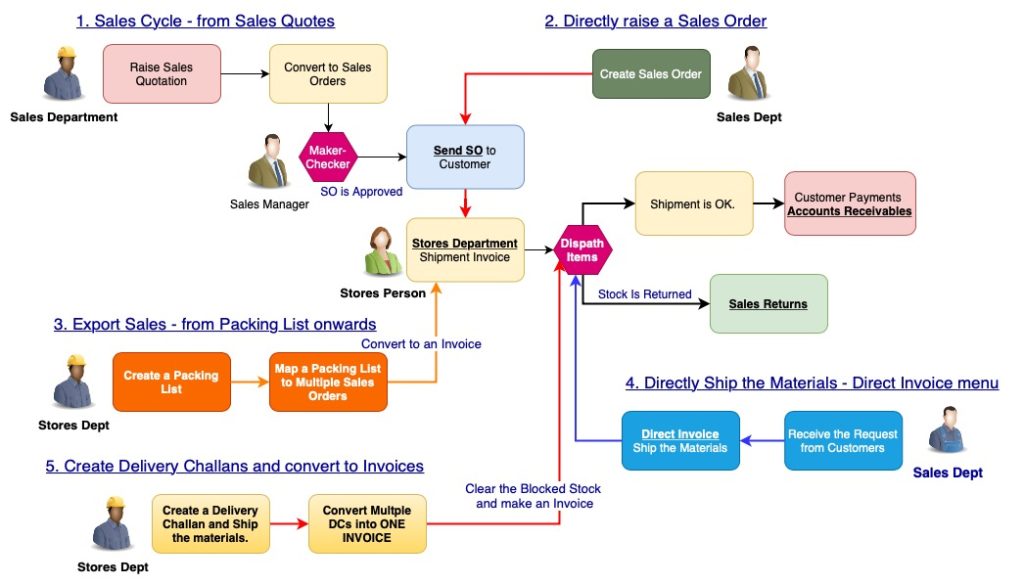Sales Order in Business: Streamlining Operations
What is Sales Order in Business?
Sales Order in business is a crucial process in the manufacturing industry that encompasses the entire lifecycle of an order, from its placement to fulfillment. It involves the coordination of various activities such as order entry, order processing, inventory management, invoicing, and shipment tracking. By effectively managing sales orders, manufacturers can streamline their operations, ensure timely deliveries, and maintain customer satisfaction.
Sales order process consists of multiple steps to follow with receipt of Sales agreements / Purchase Orders from customerwith an intention to buy. As part of sales process, we prepare our Finished Items based on internal documents of inventoryand production, and prepare a sales invoice based on customer sales order documents and sales order details. Once the items are shipped to Customer, he would release the payments as per the terms of sale agreed between them.
These pending invoices would appear in the Balance sheet as Accounts Receivable. Normally a sales order documents contains details like Customer billing address, Customer shipping details / delivery address and where to ship materials, itemized list with unit Price before taxes, Product pricing details, agreed payment method and credit terms on when the payment can happen etc.
Let’s consider an example to illustrate the concept. Imagine a manufacturing company that produces electronic devices. When a customer places an order for a specific quantity of smartphones, the sales team enters the order details into the system, including the product, quantity, delivery date, and customer information. This initiates the Sales Order Management process.
Sales Order is important for Companies
Sales Order in Business plays a pivotal role in the success of manufacturing companies. Here are some key reasons why it is essential:
a. Efficient order processing: Sales Order enables manufacturers to process orders swiftly and accurately. By automating the order entry process, errors and delays are minimized, leading to improved customer satisfaction.
b. Inventory optimization: By integrating Sales Order with inventory management systems, manufacturers can monitor stock levels in real-time. This enables them to fulfill orders promptly, reduce stockouts, and avoid overstocking, thereby optimizing inventory and reducing carrying costs.
c. Enhanced customer experience: With effective Sales Order Management, companies can provide customers with accurate order status updates, timely delivery notifications, and improved post-sales support. This leads to higher customer satisfaction and increased loyalty.
d. Order tracking and visibility: Sales Order Management systems enable companies to track orders throughout the entire fulfillment process. This visibility allows them to proactively address any issues that may arise, such as delays or potential bottlenecks, ensuring smooth order flow.
e. Streamlined financial processes: Integrating Sales Order Management with accounting systems simplifies the invoicing and payment processes. This streamlines financial operations, reduces billing errors, and enhances cash flow management.
Sales Order Processing Flowchart that links between departments – ACTouch Cloud ERP Software process.

What are the 5 steps to follow for a Sales Order in Business?
The Sales Order Management process typically involves the following steps.
a. Order entry: The sales team captures order details, including the product, quantity, price, and customer information, and enters them into the Sales Order Management system.
b. Order validation: The system validates the order for accuracy and completeness. It checks factors such as product availability, pricing consistency, and customer credit limits.
c. Order processing: Once validated, the system processes the order by generating picking lists, packing slips, and invoices. It also updates the inventory levels accordingly.
d. Shipment and delivery: The system coordinates with the warehouse or distribution center to pick, pack, and ship the ordered items. It generates shipping labels and provides tracking information to both the company and the customer.
e. Invoicing and payment: After shipment, the system generates an invoice and sends it to the customer. It tracks payments and updates the financial records accordingly.
For example, let’s consider a textile manufacturer.
When a retailer places an order for 500 yards of fabric, the sales team enters the order details into the Sales Order Management system. The system validates the order, checks the inventory for availability, and processes the order accordingly. Once the fabric is packed and shipped, an invoice is generated and sent to the retailer, with payment terms specified.
How does Sales Order Management work?
Sales Order Management involves the integration of people, processes, and technology to streamline the order fulfillment process. Here are a few examples of how it works in practice:
a. Automated order processing: With a robust Sales Order Management system, incoming orders can be automatically captured, validated, and processed. For instance, when a customer submits an order online, the system can automatically validate the order details, update inventory levels, and generate picking and packing lists, reducing manual intervention and minimizing errors.
b. Integration with inventory management: Sales Order in business systems can be integrated with inventory management software to maintain real-time visibility into stock levels. For instance, when an order is received, the system can check the availability of products in the warehouse and suggest alternatives if the requested items are out of stock. This integration ensures accurate order fulfillment and prevents stockouts.
c. Order tracking and alerts: Sales Order Management systems allow companies to track orders at various stages of the fulfillment process. For example, when an order is shipped, the system can provide real-time tracking information to the customer, enabling them to monitor the progress of their order. Additionally, the system can send alerts to both the company and the customer in case of any delays or issues.
|
What’s the use of Sales Order in Business? How does it help businesses?
Sales Order Management offers several benefits to businesses in the manufacturing industry. Here are some key advantages:
a. Increased operational efficiency: By automating order processing and integrating it with inventory management and other systems, Sales Order Management eliminates manual errors, reduces processing time, and enhances overall operational efficiency. This enables manufacturers to fulfill orders faster and more accurately.
b. Improved customer satisfaction: With streamlined order processing, accurate order tracking, and timely delivery notifications, Sales Order Management enhances the customer experience. Satisfied customers are more likely to become repeat buyers and advocates for the brand, driving business growth.
c. Enhanced inventory management: Sales Order systems provide real-time visibility into inventory levels, enabling manufacturers to optimize stock levels, prevent stockouts, and reduce carrying costs. This ensures that the right products are available at the right time, minimizing inventory holding and improving cash flow.
d. Effective resource allocation: By streamlining the order fulfilment process, Sales Order helps businesses allocate resources more effectively. It enables them to allocate manpower, equipment, and materials efficiently, reducing wastage and optimizing productivity.
e. Accurate financial management: Integrating Sales Order systems in business with accounting systems ensures accurate and timely invoicing, improves cash flow management, and simplifies financial reconciliation processes. This leads to better financial control and decision-making.
In conclusion, Sales Order in business plays a crucial role in the manufacturing industry by streamlining order processing, enhancing inventory management, improving customer satisfaction, and optimizing overall business efficiency. By leveraging the benefits of Sales Order Management, companies can strengthen their competitive position, drive growth, and deliver exceptional value to their customers.


